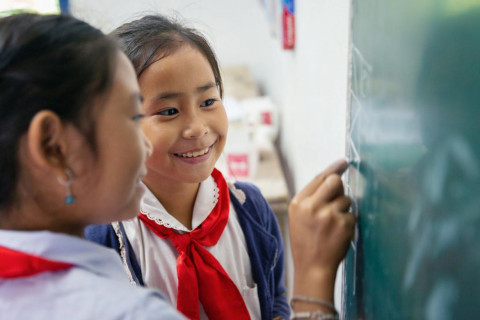
GCED Basic Search Form
Quick Search
You are here
News

Designed to be used by gender focal points and education planners and implementers, this toolkit introduces key concepts and theoretical debates, and outlines practical approaches for mainstreaming gender equality throughout the education system, and within education policy.
This year we are marking Beijing+25 as a pivotal milestone for the achievement of gender equality, girls and women’s empowerment, and inclusive and equitable quality education enshrined in Sustainable Development Goals (SDGs) 4 and 5. We may find ourselves asking once again: What has changed for women and girls around the world, and what progress can we see towards realizing gender equality in and through education?
Steps towards gender equality in education in Asia-Pacific
Achieving gender parity in education enrollment and completion is an essential first step towards achieving gender equality in education. The Asia-Pacific region, on average, has achieved gender parity in primary, lower secondary and upper secondary education enrollment (GPI is .98, 1.002 and 1.013 respectively; UNESCO, 2019).
At the tertiary level, while globally women remain underrepresented in some science and technology fields, there are promising examples from Asia-Pacific. For example, almost half of graduates in engineering are female in Bangladesh (46%) and Brunei (48%), and the same is true for Information Technology (IT) graduates in India (50%), the Philippines (48%) and Thailand (48%).
However, although the emphasis is often placed on increasing access to safe learning, it is important to note that this is not the only barrier to gender equality. Ensuring equal access to quality teaching and learning opportunities remains a challenge.
Harmful social norms hold girls back
The region still has much to do in improving the lives of women and girls who face violence, economic exclusion, and lack of political representation. Harmful socio-cultural norms and structural inequalities are a major barrier to schooling for adolescent girls in particular.
Early marriage and pregnancy, which are often accompanied by social stigma, forced exclusion from school and higher rates of health complications following birth keep many girls out of upper secondary education even if they manage to complete lower secondary education. While the early marriage rate is less than 10% in Kazakhstan (7%), Mongolia (5%), Tonga (6%) and Turkmenistan (6%), it remains high in Bangladesh (59%), Nepal (40%), Lao PDR (35%) and Afghanistan (35%) (UNESCO, 2019).
Compounding these poor sexual and reproductive health outcomes that keep girls from completing their education is a lack of quality comprehensive sexuality education (CSE). Only six countries in the region, Cambodia, China, Indonesia, Nepal, Papua New Guinea and Vietnam, have detailed CSE policies and while most have some form of national CSE curriculum, few include CSE at the primary level and data suggests that any implementation of existing curricula may be weak (2015).
Girls are often expected to stay at home to undertake domestic duties or care for younger children and girls in rural areas are particularly likely to be excluded from schooling. Supply-side factors, such as poor school facilities and services (e.g. lack of segregated latrines or menstrual hygiene management facilities), lack of boundary walls and unsafe routes to school and incidence of school-related gender-based violence mean that parents can be reluctant to send their daughters to school. WHO/UNICEF found that 18% of primary and 13% of secondary schools worldwide had no sanitation facilities. This includes 19% of secondary schools in Oceania (excluding Australia/New Zealand) and 18% in Central and Southern Asia.
Boys and men cannot be excluded from gender equality efforts. In many countries in the region, male learners face just as many or more obstacles as females in accessing, participating in and achieving in education (2018). In the Philippines, for example, the out-of-school rate for youth of upper secondary school age in the poorest quintile was 13.88% for females and 26.35% for males (2017).
However, despite their own barriers to education, boys and men can also serve as important influencers in achieving equal access to education. The Parivartan program in India took note of this, training cricket coaches on promoting gender-equitable attitudes and approaches to address gender-based violence.
Finally, in times of emergencies, these vulnerabilities are heightened. The recent global health crisis has disrupted education at unprecedented rates and, in many cases, has exacerbated gender inequalities in education through increased rates of domestic and gender-based violence, limited opportunities for girls to learn at home and increased disengagement in school by boys (2020).
Gender in Education Network in Asia-Pacific (GENIA)
The recently reactivated Gender in Education Network in Asia-Pacific (GENIA), hosted by UNESCO Bangkok, responds to these critical challenges through collaboration, advocacy, and partnership.
As of May 2020, the network is comprised of 20 Gender Focal Points (GFP) from Ministries of Education in 19 countries who support gender equality through coordinated efforts and activities. GENIA encourages member countries to strengthen their approaches to gender equality and provides a platform for better monitoring of progress and challenges across the region.
GENIA Toolkit: Promoting gender equality in education
The revised and updated GENIA Toolkit provides training materials and resources to support GFPs, education planners and implementers address these ongoing challenges. The Toolkit introduces key concepts and outlines practical approaches for mainstreaming gender equality throughout the education system and within education policy.
The toolkit can be used as a self-study tool and by trainers who are designing and delivering courses or training sessions on achieving gender equality in education. There is a wide range of tools in the kit, covering all levels of the education system and key thematic areas including education in emergencies, gender-based violence, teacher education and strategic planning.
By sharing successes to advancing gender equality in education and collaborating to address areas where there remains a crucial need for progress, the GENIA network and toolkit are valuable contributions to advancing the realization of SDG 4 and SDG 5 in Asia-Pacific.
by Juliette Myers, Enabling Education Network and Amelia Martin, UNESCO Bangkok
URL:
https://www.globalpartnership.org/blog/new-toolkit-gender-equality-asia-pacific

